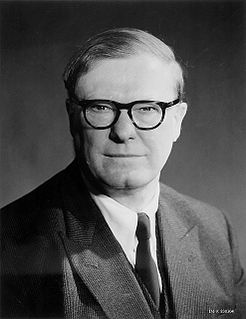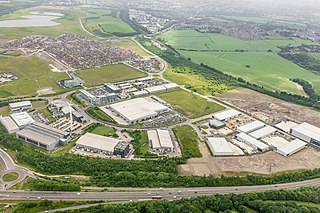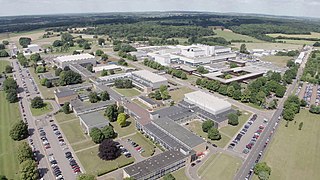
The Atomic Energy Research Establishment (AERE) was the main centre for atomic energy research and development in the United Kingdom from 1946 to the 1990s. It was created, owned and funded by the British Government.

The United Kingdom Atomic Energy Authority is a UK government research organisation responsible for the development of nuclear fusion power. It is an executive non-departmental public body of the Department for Business, Energy and Industrial Strategy (BEIS).

Dounreay is a small settlement and the site of two large nuclear establishments on the north coast of Caithness in the Highland area of Scotland. It is on the A836 road nine miles west of Thurso.
Ricardo-AEA Ltd, trading as Ricardo Energy & Environment, was formed on November 8, 2012, when Ricardo acquired the business, operating assets and employees engaged in the business of AEA Technology Plc, for a total cash consideration of £18.0 million.
PLUTO was a materials testing nuclear reactor housed at the Atomic Energy Research Establishment, a former Royal Air Force airfield at Harwell, Oxfordshire in the United Kingdom.

The National Energy Technology Laboratory (NETL) is a U.S. national laboratory under the Department of Energy Office of Fossil Energy. NETL focuses on applied research for the clean production and use of domestic energy resources. NETL performs research and development on the supply, efficiency, and environmental constraints of producing and using fossil energy resources, while maintaining their affordability.

William George Penney, Baron Penney, was an English mathematician and professor of mathematical physics at the Imperial College London and later the rector of Imperial College. He had a leading role in the development of Britain's nuclear programme, a clandestine programme started in 1942 during World War II which produced the first British atomic bomb in 1952.
Fire protection engineering is the application of science and engineering principles to protect people, property, and their environments from the harmful and destructive effects of fire and smoke. It encompasses engineering which focuses on fire detection, suppression and mitigation and fire safety engineering which focuses on human behavior and maintaining a tenable environment for evacuation from a fire. In the United States 'fire protection engineering' is often used to include 'fire safety engineering'.

Winfrith Atomic Energy Establishment, or AEE Winfrith, was a United Kingdom Atomic Energy Authority site near Winfrith Newburgh in Dorset. It covered an area on Winfrith Heath to the west of the village of Wool between the A352 road and the South West Main Line.

The Advanced Manufacturing Park (AMP) is a 150-acre (61 ha) manufacturing technology park in Waverley, Rotherham, South Yorkshire, England. It was partly funded by the European Regional Development Fund, and developed by the Harworth Group, previously the property development wing of UK Coal, on reclaimed opencast coal mine land close to the site of the battle of Orgreave.

The Harwell Science and Innovation Campus is a 700-acre science and technology campus in Oxfordshire, England. Over 6,000 people work there in over 240 public and private sector organisations, working across sectors including Space, Clean Energy, Life Sciences and Quantum Computing.

The Gubkin Russian State University of Oil and Gas is a public university in Moscow, Russia. The university was founded in 1930 and is named after the geologist Ivan Gubkin. The university is colloquially known as Kerosinka, meaning 'kerosene stove'.

Dorset Innovation Park is a science and technology park which is owned by the Homes and Communities Agency. The site was the former UKAEA Winfrith Atomic Energy Establishment which was in service from the 1950s to early 1990s. The Steam Generating Heavy Water Reactor was also developed at the site.

The oil and gas industry plays a central role in the economy of the United Kingdom. Oil and gas account for more than three-quarters of the UK’s total primary energy needs. Oil provides 97 per cent of the fuel for transport, and gas is a key fuel for heating and electricity generation. Transport, heating and electricity each account for about one-third of the UK’s primary energy needs. Oil and gas are also major feedstocks for the petrochemicals industries producing pharmaceuticals, plastics, cosmetics and domestic appliances.

DNV is an international accredited registrar and classification society headquartered in Høvik, Norway. The company currently has about 12,000 employees and 350 offices operating in more than 100 countries, and provides services for several industries including maritime, oil & gas, renewable energy, electrification, food & beverage and healthcare. DNV GL was created in 2013 as a result of a merger between two leading organizations in the field — Det Norske Veritas (Norway) and Germanischer Lloyd (Germany). In 2021, DNV GL changed its name to DNV, while retaining its post-merger structure.
Arthur Marshall Stoneham, FRS, known as Marshall Stoneham, was a British physicist who worked for the United Kingdom Atomic Energy Authority, and from 1995 was Massey professor of physics at University College London.

The Culham Centre for Fusion Energy (CCFE) is the UK's national laboratory for fusion research. It is located at the Culham Science Centre, near Culham, Oxfordshire, and is the site of the Joint European Torus (JET), Mega Ampere Spherical Tokamak (MAST) and the now closed Small Tight Aspect Ratio Tokamak (START).
Brian Leonard Eyre CBE, FRS, FREng was a British material scientist, Chief Executive of the United Kingdom Atomic Energy Authority (UKAEA) and Professor at the University of Liverpool. He was also a visiting scholar at the University of Oxford and University College London.

The Department of Mechanical Engineering is responsible for teaching and research in mechanical engineering at Imperial College London, occupying the City & Guilds Building at the South Kensington campus. The department has around 45 faculty members, 600 undergraduates, and 250 postgraduate students. The department ranks 8th in the QS World University Rankings's 2018 table.













